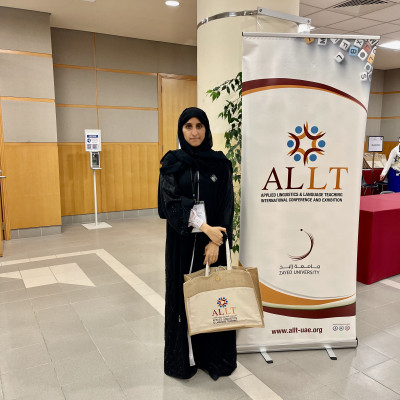Sessions / Location Name: Silang Jana 3
Physical Location
Location: (7)
Building: Aston Hotel < Aston Denpasar Hotel & Convention Center
Non-English major college students self-selected ER materials and practices #3863
Extant studies have demonstrated that college students generally perceive extensive reading positively, particularly those from English major. However, a little is known the perceptions and practices of non-English major college students after four months taking an extensive reading course. 86 colleges students with diverse disciplinary and cultural backgrounds participated in this study. They took extensive reading course as an elective subject in partial fulfilment for their bachelor's degree. They were asked to select a book based on their interest and recorded what they read, when, and amount of time spent for reading the book during four months. After implementing extensive reading for four months, the participants were asked to complete a questionnaire that looked at their choice of books, opinions and attitudes towards extensive reading, level of enjoyment, and their language learning growth based on their own judgement. We found that in terms of book selection, the participants selected books based on personal interests, cultural backgrounds, or academic requirements. The participants who viewed reading as a task or chore did not experience the same language acquisition benefits as those who viewed it as a pleasurable activity. The participants who found that reading was enjoyable, they were more likely to continue reading and spend more time engaged in the activity. This increased exposure to the language may lead to greater language acquisition. These findings are pivotal to further explain what works in conducting extensive reading for non-English major college students.
ER and TOEFL ITP scores #3711
This presentation will report on a study that extends an earlier pilot study on extensive reading and TOEFL ITP progress. The pilot study found only a small correlation between score achievement on the test and the amount of extensive reading and listening on an eight-month intervention. For the current study, reading, listening, and TOEFL ITP data for two cohorts in the same program (280 subjects in total) were considered. During the intervention, students in these cohorts were more strongly encouraged to make use of the audio (reading while listening), and they were occasionally asked to read non-fiction graded readers in preparation for in-class activities. The results of the current study will be discussed, along with how the program has attempted to find a better configuration of program elements to help students see greater scores on the TOEFL ITP, the largest institutional measurement tool of student English proficiency improvement.
Correlation of reading speed, engagement, and comprehension in online ER #3759
Students should read comfortably and at an adequate speed when doing ER. Reading duration, time-on-task, and effort are measures of reading engagement promoting reading comprehension. In the digital era, ER has shifted to online platforms. This study investigated the relationships between the reading speed, engagement, and reading comprehension of 34 Thai university students using XReading for six weeks. The time spent and number of activities were also collected using separate record forms. A Likert-scale questionnaire assessed the participants’ reading engagement. A Pearson r correlation revealed positive relationships between comprehension and indicators of reading engagement; namely, time-on-task (r = 0.62, p = 0.00), and reading engagement (r= 0.80, p=0.00) and reported no correlation for reading speed (r = -0.06, p = 0.77) and the numbers of activities (r = 0.08, p = 0.66). The implications for online ER practices and their limitations will be discussed.
An exploration of Indonesian EFL students’ flow and extensive reading #3689
This research project investigated the students’ flow experience (FE) when reading extensively and conditions that enabled their FE. The participants were 36 Indonesian university students who studied at an English department and enrolled in two reading classes. They read extensively and individually chose books which were available in X-Reading. The data of this study were collected by distributing surveys and observing students’ ER. The findings showed that when reading extensively, the students did experience flow and it happened mostly due to their interest in their reading material. In general, the students read more in the second semester than in the first semester. Although students read more words in the second semester, the correlation between FE and the sum of words that the students read was weak. The goal condition of FE was also found as the lowest variable in both semesters. The findings indicated the importance of guiding students to set their weekly goal and motivate their ER practice to facilitate opportunities for FE and increase the quality of their language learning.
Using ER, read-aloud, and speed reading in active learning EFL classrooms #3749
This presentation shows examples of how extensive reading is integrated into course designs that focus on the active skills of speaking and writing. The practices showcased have been applied in college English skills classrooms in Japan and also in elementary school classrooms, sometimes with college student-instructors in a Service-Learning class design. The ER component comes from the use of level-appropriate vocabulary and the large amount of class time devoted to reading without much deliberate language teaching. We argue that extensive reading using XReading, read-aloud, and speed reading, combined with vocabulary and linked skills activities can be effective in active learning classrooms and in increasing learner confidence, motivation, and comprehension. In the college setting, success was measured by semester word count and self-reported goal achievement. In the elementary school class, schema building, pre-teaching vocabulary, an engaging worksheet, and activities sustained reading time over a large part of the session.
Reading out loud: Aid or interference to reading comprehension? #3756
Are the benefits of reading out loud in a second language exaggerated or misplaced? Students with a strong background in having books read to them out loud may demonstrate good English pronunciation and smooth reading when they themselves read out loud. Good pronunciation and/or smooth reading when reading out loud, however, does not appear necessarily reflect the readers comprehension of the text. Indeed, it would appear that a student’s pronunciation and/or smoothness in reading out loud should be used as an ancillary means of measuring a student's ability to understand the meaning of a text. The presentation will discuss a series of pedagogical experiences and research-based conclusions that have challenged his previously misguided assumptions in this regard, and which have led to his recently modified approach to reading out loud in L2.
Flow experience in ER instruction for Japanese learners of English #3776
Studies (Kirchhoff, 2013; Arai, 2022) show that English learners experience "flow" (Csiksentmihalyi, 1990) during extensive reading (ER), but positive effects on performance have not been confirmed. This study addressed three questions: (1) whether learners experience flow in in-class ER, (2), whether learners who do engage in more out-of-class reading than those who do not, and (3) how reading attitude (RA) (Yamashita, 2007) of learners who do differs from those who do not. Of the 31 participants in this study, eight experienced flow, and the average number of words and time spent on out-of-class ER was higher for them compared to those who did not. Additionally, those who experienced flow had higher average values for several components of RA. Further research is needed to determine whether experiencing flow during in-class ER enhances out-of-class ER performance. Additionally, more investigation is required to identify the components of RA that facilitate flow in ER.
How do three modes of extensive reading affect learner vocabulary size and reading rate? #3709
Previous Extensive Reading (ER) studies almost exclusively focus on English language learners and tend to be limited by their lack of control over how the ER treatment is conducted and assessed. Furthermore, studies that investigate the possible effects of different styles of ER, including Extensive Listening (EL) and Audio-assisted Extensive Reading (AER), are few. The goal of this study was to investigate the possible effects of monitored ER, EL, and AER on the vocabulary acquisition, reading rate, and comprehension of learners of Japanese as a foreign language (JFL). Using an experimental design, data collection for the second year of this three-year project (currently including data from 150 elementary and intermediate JFL learners) has been completed. Current data indicate mixed results from these three modes of ER. Pedagogical implications and future directions will be discussed.
Indonesian students’ response to extensive reading in learning grammar #3801
In learning a foreign language, students’ language input can be obtained through extensive reading (ER) as they have more opportunities to engage with vocabulary and grammar of the language. Many studies have explored the benefits of ER for reading skills, but few discuss about its effect towards students’ grammar. This study focused on the perceptions of 20 Indonesian university students of the practice of ER in learning English grammar. The data was taken from students’ weekly learning log that reports their ER practice and an online questionnaire that probed into their perception about the effectiveness of ER in grammar learning. The study adopted a qualitative approach and content analysis was used to analyze the data. The results show that most students were benefited from ER practice in improving their grammar; however, some reported difficulties in implementing ER. The study recommend implementing ER in students’ English grammar learning.
The effects of ER on university students versus younger learners. #3778
This study compares the effects of Extensive Reading (ER) on university students’ and younger learners’ English proficiency. Although ER is recognized as one of the best methods to improve learners’ English proficiency, many Japanese universities limit its practice to one academic year. In this study, twelve students aged 9 to 11 started ER using easy English picture books and Graded Readers over 3 to 4 years. After reading approximately 250 – 300 books, the presenter implemented grammar lessons in addition to ER. Then, the Edinburgh Project on Extensive Reading Placement/Progress Test (EPER PPT) was administered. These tests show that younger learners who practiced ER for several years had better results. The presenter postulates that the implementation of ER earlier in the formal English education process and practice for a longer duration would greatly benefit learner’s progress in English.
ER program for the development of reading fluency of Japanese EFL learners #3765
This research investigates how Japanese EFL learners improved their reading fluency in an extensive reading and listening program, which is designed based on the findings from research emphasizing the importance of bottom-up processing (Kadota, 2015). It consists of 12 sessions in four months including lectures and tasks to develop students’ lower-level language processing, such as phoneme, word recognition practices, and syntactic analysis. The participants were the students who expressed an interest in enrollment in the program. They were required to read more than 10,000 words per week. In this presentation, we will discuss how well the tasks worked and the reading fluency of the students improved, analyzing the results of the tasks including the scores from pre/post tests, the word per minute (WPM) of timed reading exercises, and the responses of the pre/post questionnaires, which asked about their beliefs and attitudes toward reading in English.
Does graded reader difficulty affect improvement in learner reading speed? #3851
This study investigates how the length and level of graded readers affects Japanese EFL college students’ (CEFR A2 level) reading speed. Participants freely chose and read English-graded readers outside of class for 14 weeks. Then they took a test to measure their reading speed while reading passages with comprehension questions before and after the duration of the activity. The results of the tests showed there was no statistically significant difference (p = .904) in the reading speed between the students who read short, easy graded readers (on average 1,805-word books, in total 31,064 words) and the students who read long, advanced ones (on average 5,023-word books, in total 51,836 words) although the latter group read significantly more words (p =.002, r =.45) within the period. Thus, even though some students tend to read advanced graded readers when given the opportunity, to improve their reading fluency, teachers of extensive programs should recommend easier reading materials.
Enhancing students’ extensive reading practice via ReadTheory.org #3866
Extensive reading can be the best way for the first year university students to develop their language competencies. However, most of them do not read in English extensively once they leave the classroom. This study explores the implementation of extensive reading through ReadTheory.org. Studies into the use of gamification, “the use of game design elements in non-game contexts” (Deterding et al, 2011, p.9) for language learning, has found positive results on language development and enhancing learner engagement toward the learning process. This research presents the results for a study into the use of a gamified reading website, Readtheory.org, that incorporates the use of gamification elements of badges, knowledge points (KPs), levels, and feedback to enhance reading comprehension. This study examines 40 undergraduate university students’ attitudes, motivation, autonomy, and perceptions toward enhancing their extensive reading skills through ReadTheory.org. The data were collected from students’ interviews and questionnaires. The findings showed that students' attitudes are high toward the gamified platform and that the utilization of ReadTheory motivates students to read independently using the website inside and outside the classroom. The main advantage of ReadTheory is it can be easily used anywhere-anytime, a better alternative to traditional reading methods and it can be adopted to enhance student’s reading comprehension.
What activity theory tells us about how learners experience an ER program #3795
In this presentation I will discuss how prior reading experience and assessment influence the level of agency learners feel when part of an extensive reading programme, using the lens of Activity Theory (Galperin, 1969). Activity Theory takes the position that human activities should be understood as systemic and socially situated. For example, the extensive reading approach argues for learners selecting their own reading material and reading at their own pace (Day and Bamford, 2002). However, little is known about the factors that influence learners' reader selection and how students engage with graded readers, as a socially situated and systemic activity. The data in this presentation is taken from interviews with seven participants in an extensive reading programme at a private university in central Taiwan at three stages of the second semester (beginning, middle and end). Data was transcribed and coded for themes. Findings reveal that prior experience reading in English, selecting appropriate reading material and assessment negatively affect the agency learners feel they have when engaged in an ongoing cycle of selecting reading material and poring over text.
The dangers of the Lexile System to extensive reading #3721
The Lexile system by Metametrics is a popular rating system used widely in the United States and elsewhere which purports to rate both the reading level of books and the ability level of students on the same scale. Unfortunately, the reading level algorithm does not take into account the vocabulary or syntactic patterns used in the texts, but only mechanically measurable qualities of the text such as average sentence and word length. Parents, teachers and librarians use the system to classify books and determine which ones might be suitable for students. It simply does not work for L2 students. This paper will attempt to explain why the system does not work and the potential dangers of employing it for students for which it was not designed.
How readers can be Assisted: Quiz taking or discussion #3772
This study demonstrates learners’ learning paths in their extensive reading (ER) progress using two types of scaffolding for comprehension monitoring: quiz taking and discussion. Although the importance of socially constructed meaning is emphasized in critical literature (Gee, 2003), such a reading comprehension perspective has been investigated less in L2 ER literature. To promote outside-of-class ER using online materials in the Japanese high school context, the effects of two different types of self-selected scaffolding regarding spontaneous reading were examined, i.e., online comprehension quizzes and a cyber classroom where learners discuss books they had read. The results of the mixed methods —semi-structured survey and target students’ interviews —revealed that the quizzes could give learners with less confidence in L2 an explicit scale of their cognitive competence; however, the collaborative practice was more promising for establishing their reading habits and enhancing self-efficacy as they realized their identities as community members.
Extensive reading closes the gap between IELTS scores & study abroad dreams #3713
University students wishing to study abroad need to meet minimum language proficiency levels on tests such as IELTS. Japanese students have struggled to meet these minimum levels despite wanting to study abroad. To address this issue, ten Japanese students who wished to study abroad participated in an extensive reading project for one academic year to improve their IELTS reading scores. Extensive reading was monitored through use of a daily reading log and journal. Participants had full autonomy to choose reading material, but were also provided with a subscription to the Xreading online graded reader library. Participants took the IELTS test twice during the year. Seven of the participants obtained IELTS reading scores of 5.5 or higher, and six obtained overall band scores of 5.5 or more by the end of the year. Extensive reading helped bring participants’ dream of studying abroad closer, but this was dependent on the amount read.
Empowering Learners: Building fluency in the classroom to support ER and EL #3675
A common understanding of the term 'fluency' is the ability to use speak a language you have been given or chosen to learn without thinking about it, to do just what needs to be done with language in any situation. For most people, this means accurate and appropriate use of language, which whether they realize it or not, includes many aspects of linguistic knowledge: syntax, morphology, phonology, phonetics, semantics, and socio-pragmatics. Fluency, however, is just one component of the construct of language proficiency, which also includes complexity, accuracy, and lexis (Skehan, 1998). More precisely, fluency is the component of proficiency which reflects the learners' ability to spontaneously access implicit knowledge to express their ideas and exchange information quickly and continuously (Lennon, 1990; Olkonnen & Mutta, 2020; Segalowitz, 2003, 2010; Skehan, 2009). Nation (2000) claims that fluency building activity should make up 25% of a balanced language curriculum since no matter what you know, you should be able to produce it fluently. Unlike accuracy, complexity, and lexis, however, fluency has been largely ignored as a focus of classroom-based language learning, of language teacher training, of published instructional materials, and of curricular design. In this workshop, after a brief review of the research-based rationale for including fluency development activity in the ESL curriculum, participants will engage in a variety of fluency-building activities for reading and listening that will support ER, EL, and language learning, in general. Principles for choosing and designing tasks for fluency development will be used to evaluate the activities as well as help participants design practical ways in which they can include fluency development activity in their current course or curricula.
ERF & Affiliate future events: Planning and discussion #3881
This session is your chance to discuss future Extensive Reading Foundation events including ERWC7, other live events, webinars and online courses.




















